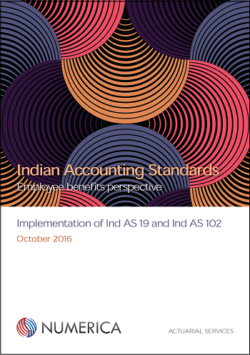
Salary escalation rate is arguably the second most significant assumption used in an actuarial valuation after the discount rate. However, unlike the discount rate, the reporting enterprise has a much greater role to play in setting this assumption. It is important to understand the complexities involved.
Actuarial reporting requirements for employee benefit schemes in India, such as gratuity and leaves (also known as compensated absences), have evolved rapidly over the last few years. Prior to 2005, before AS 15 was revised, the actuary had the overall responsibility for many important aspects of actuarial valuation.
When the AS 15 was revised, the responsibility for actuarial valuation was shifted from the actuary to the reporting enterprise. All the amendments to AS 15 since then, and the introduction of Ind AS 19, have only increased the responsibility on the reporting enterprise.
Understandably, companies require time to develop the necessary knowledge to own the actuarial reporting process. Below are some of the considerations to be kept in mind when setting the salary escalation assumption:
6 things to understand about the salary escalation assumption
1. Know the regulatory context – both AS 15 and Ind AS 19 require the salary escalation assumption to be the reporting company’s best estimate of the salary increases they are expecting to give to their employees over a long-term.
2. Setting salary escalation to be equal to the average salary increases over the reporting period is a wrong approach. Though the past experience is clearly a factor, the assumption must reflect the salary increases the company’s management expects to award in future. For example, if the average salary increase over the reporting period was 12.34%, it would still be ok to set the assumption to 5% if the company expects that the future increments will be lower.
3. The assumption should be set to be consistent with the business plans of the company. However, it is important to distinguish actuarial assumptions from ‘business’ assumptions. While business assumptions relate to the entire payroll of the company, the actuarial assumptions are limited to the existing population; i.e. future new employees are excluded. Since the salary increments tend to reduce as employees serve longer, the actuarial salary escalaltion assumption will usually be somewhat lower than the corresponding business assumption.
4. The assumption must reflect ALL types of salary increments – those related to promotions, performance, inflation and any other ad-hoc increments expected to be paid.
5. The salary escalation assumption reflects the expected ‘average’ over the entire population, as well as over time. When setting the assumption, companies must consider what Cumulative Average Growth Rate (CAGR) in salaries of the existing employees is expected over the duration of the liabilities, which could be as long as 10 to 15 years.
6. The salary escalation assumption need not be changed in response to any one-off instance of higher or lower than expected salary increases. It must be changed only when the management’s view of future salary escalation changes. For example, if the expected salary escalation was 10%, but the actual salary increases awarded amounted to 15%, this would not warrant a change of assumption from 10% to 15%, as long as the management believes that the future increments will still average at 10%.
One of our posts highlighting the issues involved in setting the discount rate can be found here and another one setting out considerations for the employee attrition rate can be accessed here. Future posts will address the issues related to mortality rates and other actuarial assumptions.
Download our guide on transitioning to Ind AS from employee benefits perspective; click on the picture below:


December 07, 2017 at 12:15 pm, How to set attrition assumption for actuarial valuation - Numerica said:
[…] our last post, considerations for setting the salary escalation rate were discussed. In the same post, we also provided some context about the roles and […]
July 30, 2025 at 4:57 pm, MAHADEVA said:
As per the policy of the company, the employees are paid a 10% increment every year. this is on the Gross salary. Hence, the escalation of salary can be considered as 6% of Basic and DA.
December 13, 2025 at 5:13 am, 5 ways in which COVID-19 impacts actuarial valuation • Numerica said:
[…] to this post for more information on how to set the salary escalation assumption for actuarial […]